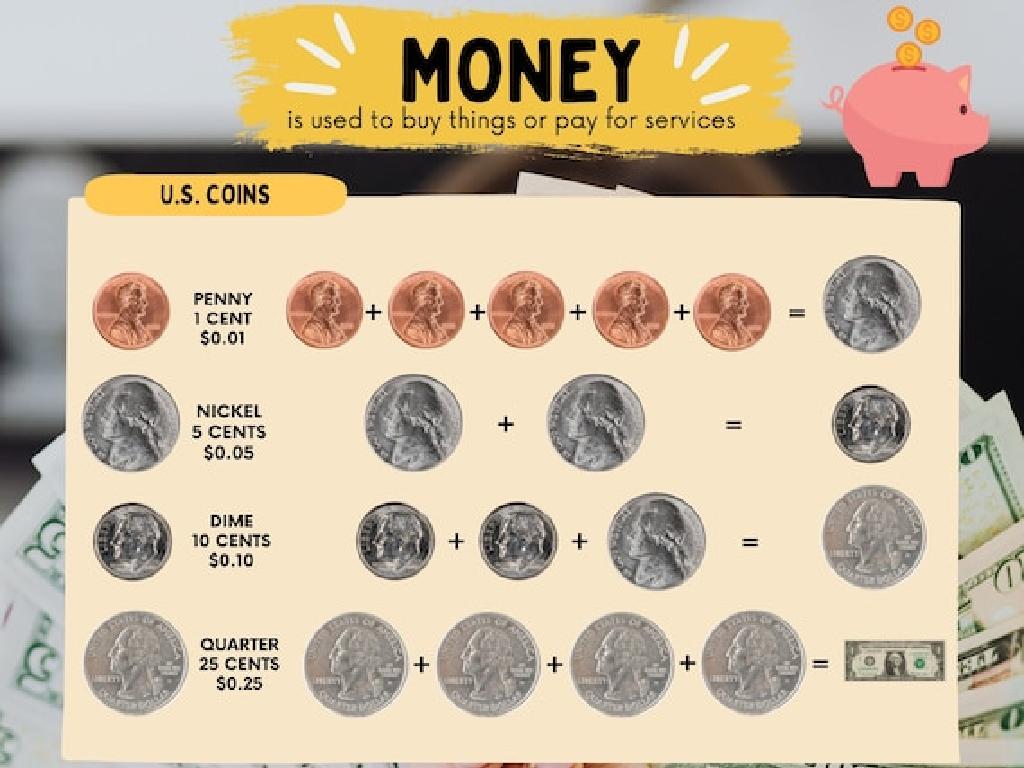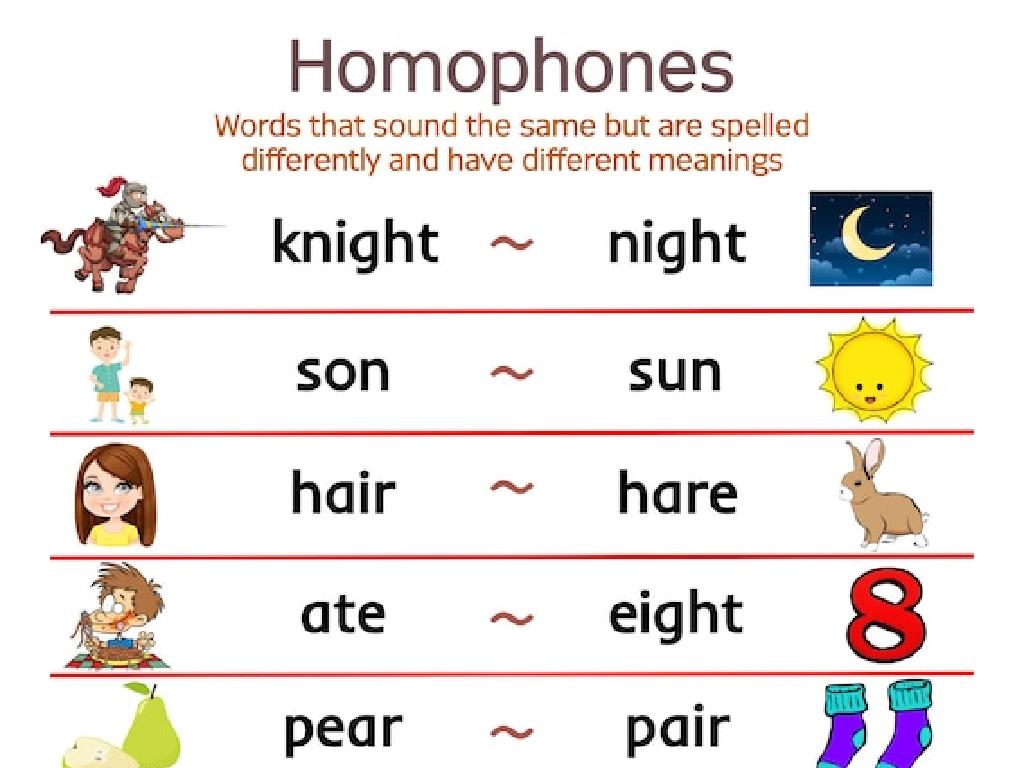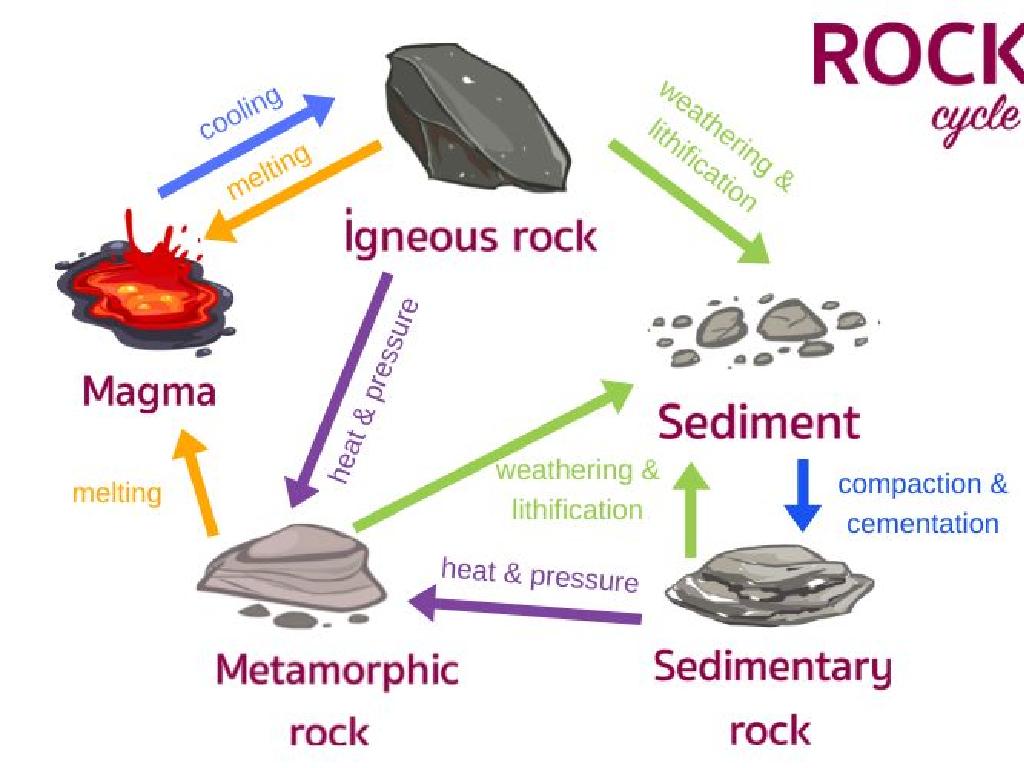Add Fractions With Unlike Denominators Using Models
Subject: Math
Grade: Fourth grade
Topic: Add And Subtract Fractions With Unlike Denominators
Please LOG IN to download the presentation. Access is available to registered users only.
View More Content
Introduction to Fractions
– Recap: What are fractions?
– Fractions represent parts of a whole
– Numerators vs. Denominators
– Top number is the numerator, bottom is the denominator
– Everyday life fraction examples
– Pizza slices, sharing candy, measuring cups
– Visualizing fractions with models
– Use shapes like circles or bars to show parts
|
Begin the lesson by recapping the concept of fractions as parts of a whole, which they have likely encountered in earlier grades. Clarify the roles of numerators and denominators in representing these parts. Provide relatable examples such as dividing a pizza into slices or sharing candy among friends to illustrate fractions in a context familiar to fourth graders. Introduce visual models like pie charts or bar models to help students better understand and visualize fractions, setting the stage for learning about adding fractions with unlike denominators.
Understanding Denominators
– Similar vs. Unlike Denominators
– Similar denominators are the same, unlike are different. E.g., 1/4 and 3/4 vs. 1/4 and 2/3
– Identifying unlike denominators
– Look at the bottom number of fractions to tell if they’re unlike
– Importance of denominator knowledge
– Knowing the difference helps in adding or subtracting fractions
– Using models for unlike denominators
– Draw pictures to see how fractions with unlike denominators can be added
|
This slide introduces the concept of denominators in fractions, distinguishing between similar and unlike denominators. It’s crucial for students to understand that similar denominators are the same, which makes adding and subtracting fractions straightforward. Unlike denominators differ and require additional steps to combine fractions. Emphasize the importance of this knowledge as a foundation for adding and subtracting fractions with unlike denominators. Use visual aids like fraction models or pie charts to help students visualize the concept. Encourage students to practice identifying similar and unlike denominators with examples and to use models to add fractions with unlike denominators.
Visualizing Fractions with Models
– Models represent fractions visually
– Picture a pizza cut into different-sized slices
– Models aid in adding fractions
– See how different slices fit together to make a whole
– Activity: Build a fraction model
– Use objects like LEGO or paper to make fractions
|
This slide introduces the concept of using visual models, such as pie charts or block builds, to help students understand and add fractions with unlike denominators. Begin by explaining that models can turn abstract numbers into something they can see and touch, making it easier to grasp the concept of combining different fractions. For the activity, provide various materials like colored paper, LEGO bricks, or fraction circles, and guide the students to create their own models representing different fractions. Then, show them how to combine these models to see the result of adding fractions. This hands-on activity will help solidify their understanding of adding fractions with unlike denominators.
Adding Fractions with Unlike Denominators
– Why not add directly?
– Fractions need the same denominator to add them, like common units.
– Finding a common denominator
– To add fractions, find a number that both denominators can divide into.
– Adding with common denominator
– Use the common denominator to make equivalent fractions, then add.
– Visualizing fraction addition
– Draw models to show how different fractions can make a whole.
|
This slide introduces the concept of adding fractions with unlike denominators. Start by explaining why we cannot add fractions with different denominators directly it’s like trying to add apples and oranges. Next, demonstrate how to find a common denominator by listing multiples of the denominators and choosing the smallest common multiple. Show how to rewrite each fraction with the new common denominator and then add the numerators while keeping the denominator the same. Use visual aids like fraction circles or bars to help students understand how these fractions represent the same parts of a whole and how they can be combined. Encourage students to practice with different sets of fractions and use models to visualize the process.
Adding Fractions with Different Denominators
– Example 1: Add 1/3 and 1/4
– Find a common denominator and use models to add.
– Example 2: Add 2/5 and 3/8
– Find a common denominator and use models to add.
– Visualize with fraction models
– Draw pie charts or bar models to show fractions.
– Let’s solve these step by step!
|
This slide is aimed at helping fourth-grade students understand how to add fractions with unlike denominators through visualization and step-by-step problem-solving. Start with Example 1 by finding a common denominator for 1/3 and 1/4, which is 12. Show this process using fraction models like pie charts or bar models to help students see how the fractions combine. Repeat the process with Example 2 for 2/5 and 3/8, finding the common denominator and adding the fractions visually. Encourage students to draw their own models and guide them through the steps. The goal is for students to grasp the concept of equivalent fractions and the process of adding them together.
Adding Fractions: Practice Problems
– Problem 1: Add 3/7 and 2/6
– Find a common denominator and use models to add.
– Problem 2: Add 5/8 and 1/3
– Find a common denominator and use models to add.
– Work with a partner
– Draw models to find sums
– Use fraction circles or number lines to visualize.
|
This slide presents two practice problems for students to work on with a partner. Encourage them to find a common denominator for each set of fractions before adding. They should use visual models such as fraction circles or number lines to help them understand how the fractions can be combined. This will reinforce the concept of equivalent fractions and addition with unlike denominators. Provide guidance on drawing models and ensure they understand that the denominators must be the same before they can add the numerators. After completing the problems, have partners compare their models and discuss any differences in their approaches.
Class Activity: Fraction Addition Game
– Engage in fraction addition game
– Use fraction cards for problems
– Solve your created problems
– Discuss solutions with classmates
|
This interactive game is designed to help students practice the concept of adding fractions with unlike denominators. Provide each student with a set of fraction cards. Students will draw two cards at a time to create a fraction addition problem. They will then use models, such as fraction circles or bars, to find a common denominator and solve the problem. After solving, students will share their solutions and methods with the class, allowing for discussion and collaborative learning. Possible variations of the activity could include pairing students to solve problems together, creating a competition to see who can solve the most problems correctly, or using different models to find common denominators.
Wrapping Up: Adding Fractions with Models
– Review of today’s lesson
– We learned to add fractions with different denominators using visual models.
– Practice makes perfect
– Regular practice is key to becoming confident in adding fractions.
– Homework: Fraction worksheet
– Complete the provided worksheet to practice adding fractions with unlike denominators.
|
As we conclude today’s lesson, remind the students of the importance of understanding how to add fractions with unlike denominators using models. Emphasize that mastering this skill requires practice, and the homework worksheet is designed to reinforce what they’ve learned. The worksheet includes a variety of problems to help them apply the concept of finding a common denominator and using models to visualize the addition process. Encourage students to attempt all problems and assure them that we will review the answers in the next class to address any difficulties they may encounter.






